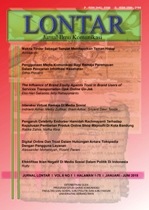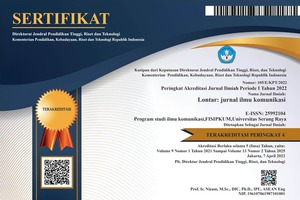Interaksi Virtual Remaja Di Media Sosial
DOI:
https://doi.org/10.30656/lontar.v6i1.646Abstract
The study is titled " Virtual Interaction of Teen on Social Media". The purpose of this study was to find out the meaning of Facebook social media for adolescents as a medium of communication in the virtual world, how teenagers express themselves through social media and show the symbol of virtual interacting contemporary teen-age.  The theory in this study is the symbolic interaction with the methodology of virtual ethnography. Techniques of determining informants using snowball technique that is through the recommendation of facebook users among adolescents aged 15-18 Years in Cilegon City. Data collection techniques are done by direct observation, in-depth interviews, and documentation. While virtual ethnographic observations are done online and offline. Online observations of researchers interact with resource persons in social media, offline researchers face to face with sources. Triangulation of sources is used in the technique of data validity. The results of this study's first teenage interpreting Facebook as an entertainment, interaction and media interaction in the virtual world. Second, teenagers can express themselves through the status update activity with slang, upload photos with "contemporary" pose and intensity of interaction by chatting to forget the time, and the dependence of updates in social media facebook.Downloads
Published
Issue
Section
License
By submitting an article to the journal, the author(s) agree to transfer the published article's copyright to the journal, which will act as the publisher. This means the journal will have the right to publish the article in various forms, including reprints. The journal will maintain the publishing rights to the published articles.
In line with the license, authors and third parties (readers, researchers, and others) are allowed to share and adapt the material. In addition, the material must be given appropriate credit, provided with a link to the license, and indicated if changes were made. If authors remix, transform, or build upon the material, authors must distribute their contributions under the same license as the original.






